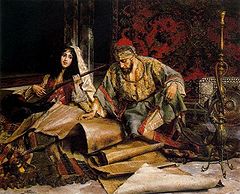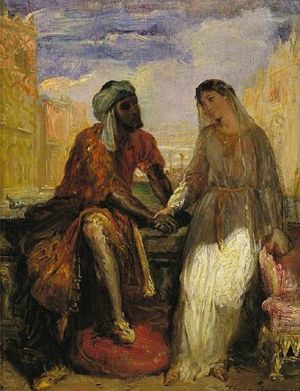Difference between revisions of "Romanticism"
(Paragraphs re-organized) |
(Further re-organizing) |
||
| Line 3: | Line 3: | ||
'''Romanticism''' was an innovative artistic, musical, and literary movement in the early 1800s which emphasized feelings, and nature. The Romantic period of art was also a period of rebirth for [[religion|religious values]]. Romanticism was against elements of the [[Enlightenment]] that emphasized [[rationalism]] at the expense of human emotion and imagination. In writing, Romanticism elevated the common man, [[nationalism]], [[freedom]], and the supernatural, while also glorifying nature. | '''Romanticism''' was an innovative artistic, musical, and literary movement in the early 1800s which emphasized feelings, and nature. The Romantic period of art was also a period of rebirth for [[religion|religious values]]. Romanticism was against elements of the [[Enlightenment]] that emphasized [[rationalism]] at the expense of human emotion and imagination. In writing, Romanticism elevated the common man, [[nationalism]], [[freedom]], and the supernatural, while also glorifying nature. | ||
| − | The term "Romanticism" was coined because it originated in European regions of the "Romance Languages," namely French, Spanish and Italian. German and British Romanticism followed soon after. Other countries such as [[America]] and [[Canada]] also had Romantic art movements. | + | The term "Romanticism" was coined because it originated in European regions of the "Romance Languages," namely French, Spanish and Italian. Novelist [[Victor Hugo]] led this movement in [[Europe]] with his works readable by the common man. German and British Romanticism followed soon after. Other countries such as [[America]] and [[Canada]] also had Romantic art movements. |
| − | [[America]]n literature typifying this era include [[Herman Melville]]'s ''[[Moby Dick]]'', [[Edgar Allan Poe]]'s writings, and the additional American writers [[Ralph Waldo Emerson]], [[Nathaniel Hawthorne]], [[Henry David Thoreau]], and [[Walt Whitman]] | + | [[America]]n literature typifying this era include [[Herman Melville]]'s ''[[Moby Dick]]'', [[Edgar Allan Poe]]'s writings, and the additional American writers [[Ralph Waldo Emerson]], [[Nathaniel Hawthorne]], [[Henry David Thoreau]], and [[Walt Whitman]]. |
[[Eugene Delacroix]] (1798-1863) was perhaps the most important of the [[French]] Romantic painters; in English literature, the Romantic movement was started by Lyrical Ballads (1798), poems co-authored by [[William Wordsworth]] and [[Samuel Taylor Coleridge]]. | [[Eugene Delacroix]] (1798-1863) was perhaps the most important of the [[French]] Romantic painters; in English literature, the Romantic movement was started by Lyrical Ballads (1798), poems co-authored by [[William Wordsworth]] and [[Samuel Taylor Coleridge]]. | ||
Revision as of 15:01, January 17, 2022
Romanticism was an innovative artistic, musical, and literary movement in the early 1800s which emphasized feelings, and nature. The Romantic period of art was also a period of rebirth for religious values. Romanticism was against elements of the Enlightenment that emphasized rationalism at the expense of human emotion and imagination. In writing, Romanticism elevated the common man, nationalism, freedom, and the supernatural, while also glorifying nature.
The term "Romanticism" was coined because it originated in European regions of the "Romance Languages," namely French, Spanish and Italian. Novelist Victor Hugo led this movement in Europe with his works readable by the common man. German and British Romanticism followed soon after. Other countries such as America and Canada also had Romantic art movements.
American literature typifying this era include Herman Melville's Moby Dick, Edgar Allan Poe's writings, and the additional American writers Ralph Waldo Emerson, Nathaniel Hawthorne, Henry David Thoreau, and Walt Whitman.
Eugene Delacroix (1798-1863) was perhaps the most important of the French Romantic painters; in English literature, the Romantic movement was started by Lyrical Ballads (1798), poems co-authored by William Wordsworth and Samuel Taylor Coleridge.

Chassériau, Othello and Desdemona in Venice.
Key Artists

- William Blake
- Henry Fuseli
- Francisco de Goya
- Eugene Delacroix
- Theodore Chasseriau
- William Turner
- John Constable
- Philippe Jacques De Loutherbourg

Key Authors
- Walt Whitman (poetry)
- Johann Wolfgang von Goethe
- E.T.A. Hoffmann
- Mary Shelley
- Sir Walter Scott
- Edgar Allan Poe
- Henry David Thoreau
- Herman Melville
- Nathaniel Hawthorne
In Literature
Literary romanticism was characterized by a series of details. It evoked the past heavily and put a great emphasis on women and children, mostly because of their purity. It wasn't associated to carnal love, as in lust, but a romantic love that was more idealistic than anything. Romanticism also had a strong nationalist sense, as can be found in Goethe's works.


